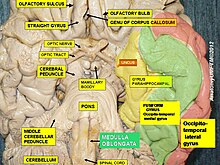Medulla oblongata
The region between the anterolateral and posterolateral sulcus in the upper part of the medulla is marked by a pair of swellings known as olivary bodies (also called olives).Just above the tubercles, the posterior aspect of the medulla is occupied by a triangular fossa, which forms the lower part of the floor of the fourth ventricle.The lower part of the medulla, immediately lateral to the cuneate fasciculus, is marked by another longitudinal elevation known as the tuberculum cinereum.[4][full citation needed] Neuroblasts from the alar plate of the neural tube at this level will produce the sensory nuclei of the medulla.The medulla oblongata connects the higher levels of the brain to the spinal cord, and is responsible for several functions of the autonomous nervous system which include: A blood vessel blockage (such as in a stroke) will injure the pyramidal tract, medial lemniscus, and the hypoglossal nucleus.[8] The status of the medulla as part of the primordial reptilian brain is confirmed by its disproportionate size in modern reptiles such as the crocodile, alligator, and monitor lizard.

Medulla Oblongata (film)Medulla (disambiguation)brain stemolivary bodyNeuroNamesNeuroLexAnatomical terms of neuroanatomybrainstemcerebellumneuronalautonomicvomitingsneezingcardiovascular centerrespiratory centervasomotorbreathingheart rateblood pressuresleep–wake cyclemyelencephalonbrain vesiclerhombencephalonbulbar palsymedical conditionsnervestractscorticobulbar tractmusclesinnervatedtonguepharynxlarynxforamen magnumskull-basespinal cordfourth ventriclecentral canalanterior median fissurepia materforamen cecummedullary pyramidspyramidal tractscorticospinal tractdecussation of the pyramidsanterior external arcuate fibersanterolateralposterolateral sulcusolivary bodiesnucleiinferior olivary nucleiposterior median sulcusposterior funiculusgracile fasciculuscuneate fasciculusgray mattergracile nucleuscuneate nucleusposterior column-medial lemniscus pathwayinternal arcuate fibersmedial lemniscusinferior cerebellar peduncletuberculum cinereumspinal trigeminal nucleustrigeminal nervecommissural fibersarteriesAnterior spinal arteryPosterior inferior cerebellar arterysynapsevertebral arterysolitary nucleusPosterior spinal arteryfasciculus gracilisfasciculus cuneatusfetal developmentNeuroblastsalar plateneural tubebasal plategeneral visceral afferent fibersspecial visceral afferenttrigeminal nerve nucleigeneral somatic afferent columncochlearvestibular nucleispecial somatic afferentinferior olivary nucleusdorsal column nucleigracilecuneate nucleihypoglossal nucleusgeneral somatic efferent fibersnucleus ambiguusspecial visceral efferentdorsal nucleus of vagus nerveinferior salivatory nucleusgeneral visceral efferent fibersautonomous nervous systemcontrol of ventilationcarotidaortic bodiesRespirationchemoreceptorsintercostalphrenicalventral respiratory groupdorsal respiratory grouppre-Bötzinger complexparasympathetic nervous systemVasomotor centerbaroreceptorsReflexpharyngeal reflexswallowingmasseter reflexblood vessel blockagestrokepyramidal tractmedial medullary syndromeLateral medullary syndromeProgressive bulbar palsyInfantile progressive bulbar palsyagnathansreptilian brainreptiles